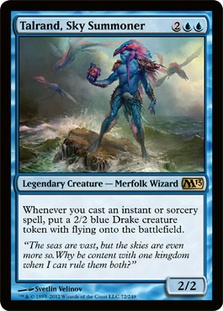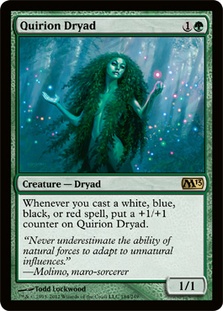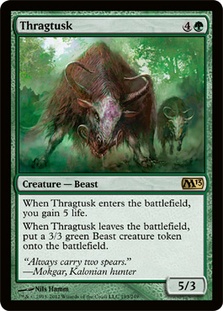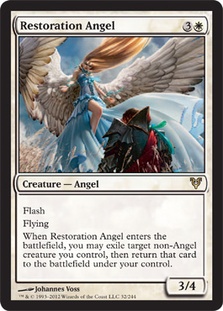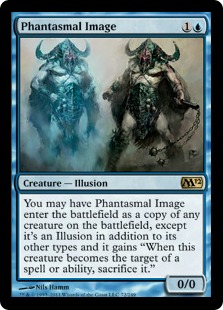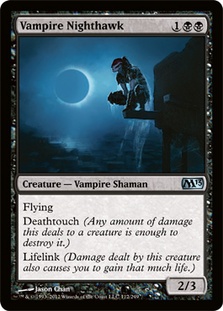I have trouble building new decks. The biggest problem for me has always been looking at something for the first time and thinking, "I’m not playing this in a tournament," or, "Isn’t this just worse than (insert known quantity here)?"
In the back of my mind, I’ve wondered whether my unwillingness to play rogue decks has ever hurt me. If you play against me in a tournament, chances are you can figure out the majority of cards in my decklist. Moreover, a prepared opponent has probably played a reasonable number of games against whatever established archetype I’ve brought to the table. People like to talk about the advantages of going rogue; the element of surprise, forcing mistakes, and taking advantage of metagamed deckbuilding. I’ve always prescribed myself to avoiding "The Danger of Cool Things."
Recently Sam Black put up a Top 8 at Grand Prix Atlanta with his innovative B/R/W Zombies deck, which you can read about here. I’ve given Sam a hard time about this deck in the past, but his result got me thinking. How many people at the Grand Prix even knew what cards were in his deck? Other than his friends, how many games had they played against it? I’d set the line at an average of 1.5 and feel comfortable taking the under. While I’m not comfortable going as deep as Sam might be, I don’t want to be stuck in the past either.
How does this apply to M13? I’ve seen lots of new "Delver" lists floating around, and I initially dismissed them. But hey, I probably felt that way about Restoration Angel too until I played a game with it. Working off of some of the lists I’ve seen, I’ll try my hand at a couple adaptations.
Creatures (15)
Lands (20)
Spells (25)
Sideboard

Talrand is a naturally powerful card that a number of other writers have advocated as a new weapon for tempo-oriented blue decks. What concerns me about some of the lists I’ve seen is that they don’t have many other real threats, which leaves Talrand as a pretty significant lightning rod. I understand that you can get value out of him right away, but it’s also more difficult to save your Gut Shots and Gitaxian Probes until turn 4 in practice than it might otherwise appear.
Quirion Dryad is a card that used to see play in similar-minded blue decks, with low land counts and lots of cantrips. It’s also the type of card that can get out of hand quickly, demanding an answer immediately. Like Delver, the card will give you some free wins, and it will also force your opponent’s hand—potentially leaving them open for a devastating Talrand a few turns down the line. The addition of green also gives us access to Thragtusk, an immensely powerful sideboard card against any aggressive deck. The combination of Thragtusk + Phantasmal Image, or even Thragtusk + Vapor Snag, has the potential to lights out for any beatdown strategy.
While there are a number of things I like about this deck, I think the next one is even more exciting. It didn’t occur to me until I started building the sideboard for the last deck, but the two interactions that I like the most with Thragtusk are Restoration Angel and Phantasmal Image. Why not put them in the same deck?
Creatures (18)
Lands (23)
Spells (19)

Built with U/W and Esper midrange decks in mind, I think this deck is capable of occupying a similar spot in the metagame. Hopefully Thragtusk gives the deck a similar amount of late-game staying power as Lingering Souls, while being a more cohesive card with our overall game plan. Restoration Angel is widely accepted as one of the best cards in Standard, and building a deck to maximize it as much as possible seems like a good way to approach the format.
Perhaps that deck is Naya or some sort of Birthing Pod deck, but I personally believe that the best Restoration Angel decks start with four Ponder and four Snapcaster Mage.
This deck seems like it would crush most beatdown decks, and access to Cavern of Souls + Thragtusk seems like a good way beat Delver. An uncounterable Thragtusk has a similar effect on the board against Delver that resolving a planeswalker would with regards to resiliency to Vapor Snag. At the same time, Thragtusk gives you a new angle of attack to combat the increasingly powerful Naya Aggro and Midrange decks, which are notoriously light on ways to interact with creatures anyway. It’s possible that the sideboard should contain Ratchet Bomb as a way to combat Lingering Souls, but I’d like to avoid playing a card that has so much anti-synergy with Blade Splicer.
This is definitely a deck I’d recommend for early tournaments in new Standard since it has an incredibly powerful proactive game plan without any obvious weaknesses. Playing one of the most powerful anti-aggro cards the new set has to offer also seems like a good way to combat the influx of aggressive cards in M13.
The final deck I’ve been thinking about takes advantage of Vampire Nighthawk. I have attempted multiple times to build a U/B Delver deck for Standard, but the deck always felt like it was a threat short. The allure of this strategy is the combo of Vampire Nighthawk + equipment.
Creatures (14)
Lands (21)
Spells (25)

Vampire Nighthawk has seen on and off play in many control and midrange blue decks over the years. Sometimes a sideboard card, Nighthawk preys on aggressive decks but is often hard to answer for control decks by benefit of being black and having three toughness. The fact that Nighthawk dodges Galvanic Blast, Pillar of Flame, and Doom Blade seems very important in current Standard. It also conveniently attacks into Restoration Angel without fear.
Vampire Nighthawk is a powerhouse with Runechanter’s Pike. In addition to the obvious benefit of being a huge, lifelinking creature with evasion, the combination of deathtouch and first strike will allow the Nighthawk to dominate in creature combat. I’m also excited to play a deck that can support Duress, which should be a nightmare for any control deck in concert with Snapcaster Mage. My main concern for this deck is a weakness to equipment, but hopefully some combination of Steel Sabotage and Duress will help in that regard.
I don’t necessarily think that any of these decks are immediately tournament ready, but they all show promise as potential contenders in Standard. The addition of four creatures into the format (Quirion Dryad, Thragtusk, Vampire Nighthawk, and Talrand, Sky Summoner) should be a boon to any players looking to play Ponder and Mana Leak for the next three months.
To those who say blue is weak in M13, perhaps you should be looking for the set’s Tarmogoyf—a card that doesn’t look blue on the surface, but somehow is at home with Island more than any other basic land.
Thanks for reading,
Matt Costa

